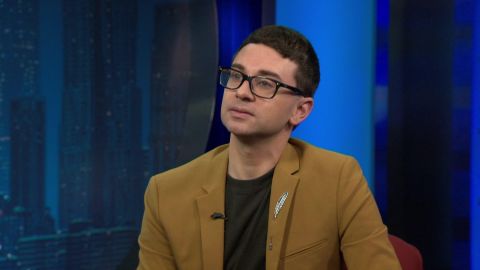Read Transcript EXPAND
CHRISTIANE AMANPOUR: And our next guest is another creative spirit, but working in an entirely different arena. Christian Siriano is one of America’s foremost fashion designers, who’s thriving at a time of major cutbacks in the industry. He’s known for his breathtaking visual imagination and for championing body positivity and diversity, both on the runway and on the red carpet. Our Alison Stewart sat down with him to discuss some of his most iconic designs and why he’s happy to break the rules.
(BEGIN VIDEOTAPE)
ALISON STEWART: What was your first memory of wanting to design something, anything?
CHRISTIAN SIRIANO, FASHION DESIGNER: Oh, my gosh. I mean, my mom and my sister were pretty, like, eccentric women. So I think — my sister would always like dress up every day for school, and she was a ballet dancer. So, I think it was something in that world. And I just was like, oh, I want to make something, because I liked seeing my sister kind of transform. She was, like, in warmups and then would put these, like, fairy costumes on. So I just always really loved that idea of, like, transformation, I think. So it was very early. I mean, I was probably like, I don’t know, 8 years old.
STEWART: What did you make? Do you remember what it was?
SIRIANO: Yes. I do actually think I remember my first thing I made. And it was bad. It was not made well. It was white tulle and feathers. And I wanted to make, like, a fairy kind of princessy dress, I think because I had seen my sister dance. And I was like, oh, I want it to be, like, fantasy world. Yes, that was probably the first thing I made. I hope my mom still has it, actually. I have to ask her.
STEWART: Oh, the way you described your mom as eccentric, I think she might still have it.
SIRIANO: Yes. Yes. She probably does.
STEWART: You have described her as your muse, actually, that your mom is your muse.
SIRIANO: Yes.
STEWART: What does that mean to you?
SIRIANO: I mean, I think, growing up, my mom — just being in a household of women, they were really inspiring, I think. My mom was — she got married in a DVF wrap dress. Like, she didn’t get married in a traditional dress. She was quite cool in what she liked. We would go shopping a lot. So I think — I don’t know. I just was inspired by her. And I think, as I was — as my business was growing and growing, I was like, I want to make clothes for someone like her. And I want to make clothes for someone like my sister, and I want to make someone, like, Lady Gaga. I don’t know.
(LAUGHTER)
SIRIANO: I just wanted all these different types of people to be able to have something of mine.
STEWART: So you’re 20 years old. You’re living in London. Right? You hear about “Project Runway.”
SIRIANO: Mm-hmm.
STEWART: What made you think, I’m going to go do that?
SIRIANO: Yes, it’s…
STEWART: What was going on in your life that that seemed like a good idea?
SIRIANO: God, I think I was broke ,and I had no — nothing to do, and I had no job, and I had no idea what I was going to do when I moved home.I was like, I lived in Europe and I was done. And I was like, OK, I have to move home. What am I going to do? And I knew I wanted to live in New York. So I was like, I’m going to live in New York. I was there for a few weeks. And my friend was like, you have to audition for this show. And I was like, I had never seen the show. So it was a hard thing. And — but I just went into it with fully open mind. Like, I had no idea what it would be. I really didn’t.
STEWART: Had you not seen the show because you were in school in the U.K.?
SIRIANO: Yes. Like, we did — it didn’t air in the U.K. So I was — I kind of knew. And I, like, semi-knew of it, but I had never really seen it. So I think that was probably also why it was — I was able to be successful, because I had no pre-anything.
STEWART: So you had no expectations?
SIRIANO: I really didn’t. And I was so young. I was 21 years old. I auditioned when I was 20. So I really just went in it as, oh, this could be fun to try, you know?
STEWART: I think of you — and take this as a compliment — like the Kelly Clarkson and Carrie Underwood of “American Idol.”
(LAUGHTER)
SIRIANO: Yes.
STEWART: That they’re such big stars now and considered artists, that people don’t even really remember that they were on a reality competition show.
SIRIANO: Yes, totally.
STEWART: That you have sort of been able to transcend that, not that it’s something that you want to leave behind, but I don’t think necessary someone thinks about that first when they think about you now.
SIRIANO: Yes, yes.
STEWART: Was there a decision that you made after “Project Runway” that helps you achieve that, whether you were trying to achieve it or not?
SIRIANO: Yes, I think it’s, like, you really have to focus on your work. I think you just have to be known for actually what you’re doing. I think any writer, any film, anyone in that field, you just want to be known for the clothes. So that’s kind of how I took it. I was like, I don’t want to be known as a character from a show. I really want to be known for, like, the beautiful clothes I make. That was always the goal. So I think that that’s what I just tried to do. I just tried to put everything into the work, dressing as many people on the carpet as I could, doing as many collaborations, showing collections season after season. That was really my focus. It’s still my focus. It really is. Like, I get requests to do projects all the time, but I’m like, no, I just like making clothes. That’s really all I like doing.
STEWART: So you won “Project Runway” in 2008. And you have got to realize the iPhone came out in 2007.
SIRIANO: I know. It’s wild.
STEWART: So it’s kind of wild. So, you’re a generation of designer who has come up during social media and during the idea of people being able to pictures right away and share them and send them. What impact do you think that’s had on your career?
SIRIANO: It’s interesting, because right when I started, Instagram didn’t exist. Twitter had just launched. It was very new, but interesting to see how it changed every year, like more and more and more. But, luckily, I think, for me, I already had a fan base that was kind of out there in the world because I was on a TV show. It was a little bit easier for me to understand how that worked. I think brands now are playing catchup, because they’re just not used to it. But, for me, I think I was a little bit more like — I don’t know. I would post a picture and people would want to buy it. It didn’t seem that strange to me. I don’t know why. And, actually, still to this day, it doesn’t really seem that strange, even though it is a strange thing.
STEWART: Well, it’s organic, because it happened at the same time. You’re…
SIRIANO: Yes. Yes.
STEWART: It’s part of your origin story of you as a designer.
SIRIANO: Yes.
STEWART: The beginning of you as a designer.
SIRIANO: And I think I actually don’t know — I don’t know anything better. I mean, I talk about this a lot like when people ask me how my business grew over the years. But my first day of market was the day that Lehman Brothers crash. I mean, every single one of my retailers canceled their appointments. I mean, but I — so, for me, though, I was like, oh, but I didn’t have sales last year. So, to me, anything was up. So, anything was success. So I think, also, that’s how I started everything, thinking that way.
STEWART: You’re a very hands-on designer.
SIRIANO: Yes.
STEWART: You sketch all of your own sketches.
SIRIANO: Yes.
STEWART: You don’t do it on the computer. You clearly do your own draping. Why?
SIRIANO: I — it’s the — actually things I like to do. I don’t want to talk about the money. I mean (INAUDIBLE) money. But I don’t want to talk about the hard thing some days. And some days,. I just want to create. Like, that’s what’s fun. That’s why I got into the business, I think. I think, sometimes, I hear that as that, oh, you didn’t have a part of this. I’m like, no, I had a part of every single thing. And some things are misses and aren’t always the most successful. But I actually am more proud of that, because then I know that, OK, we tried it and it didn’t work, and I had my hands in it a little bit. And I think it feels — I don’t know. It feels more authentic.
STEWART: Can we do a little play by play with some of your dresses?
(LAUGHTER)
SIRIANO: Yes. Yes.
STEWART: Sportscasters of fashion?
SIRIANO: Yes. Please, I would love to.
STEWART: Let’s take a look at Michelle Obama at the DNC. What was your goal for her for this look?
SIRIANO: I think the whole point was to make it powerful and have presence, but in the most simplistic way, because it is very simple dress. But I think her — that night, her speech was so important that I didn’t want the dress to overpower her.
STEWART: And you picked such a beautiful vibrant blue.
SIRIANO: Yes, yes. It just made sense with, I think, the night, yes.
STEWART: All right, Billy Porter, Tony Award winner, of course, on “Pose.”
SIRIANO: Yes. So, this was the Oscars. And you know what is so crazy about this? I mean, this was a big moment, I mean, first man to really were kind of a dress on a red carpet, which we didn’t realize at the time was going to be such a cultural thing. I just wanted to make him feel good. And he felt good in this. And that was the goal. But I think it was the right moment for this. We needed this, I think, in our culture to see that you can be masculine and feminine. There are no rules in fashion. You should have fun and feel good.
STEWART: What was challenging about making that?
SIRIANO: Honestly, it was the time, that literally we made this in a week.
STEWART: Wow.
SIRIANO: And he couldn’t even come in for a fitting because he was doing rehearsals and I was in New York. And that was the challenge. But, other than that, like, it was actually probably one of the easiest things we have ever done, yes.
STEWART: Are there crinolines under there?
SIRIANO: Oh, yes. And, I mean, Billy also, he is a performer. He can work anything. So he worked that carpet. I mean, he really, really did.
STEWART: Let’s take a look at some of the Met looks that you did.
SIRIANO: Yes, Janelle.
STEWART: This was for — this was camp, right? This is one of the themes, was camp.
SIRIANO: Camp, mm-hmm.
STEWART: So, Janelle Monae.
SIRIANO: And I think, with Janelle, she wanted to be — really, surrealism was very important to her. She wanted to feel like a walking painting. We put a mechanic in her eye, so it would blink all night long. She takes things — I mean, Janelle is amazing to create for because she’s such an artist. And she stood like that all night long. And that was very heavy. And, you know, she really commits, which I appreciate.
STEWART: So it was so interesting when Leslie Jones made it known that someone — no one would lend her a gown for the “Ghostbusters” premiere.
SIRIANO: Yes.
STEWART: I thought that was just — it was sad that it was newsworthy.
SIRIANO: Yes.
STEWART: But it was newsworthy at the time.
SIRIANO: Yes.
STEWART: How aware were you of the issue of actresses who are not — do not look like runway Paris models who have — everybody has got real bodies.
SIRIANO: Yes. Yes.
STEWART: But you know what I’m saying, but different size bodies.
SIRIANO: Yes.
STEWART: How aware were you of the issue of those actresses trying to find someone to give them a dress to wear to their movie premiere?
SIRIANO: I know. That was what was so funny. I wasn’t aware at all, because I had been — I have been dressing women that look like Leslie since my very first collection. I mean, Whoopi was one of my first people. Oprah was one of the first women I ever dressed. I mean, they’re all curvy, great women. So I just thought that was so strange. And I think Leslie was the first really to, like, announce it. She was like, this is crazy. Like, I am in a huge movie with other amazing actresses. Why can’t I get a dress? And that’s why I wanted to make her look the way we did, because I was like, people need to see, like, she’s stunning, has an amazing body. Like…
STEWART: She’s 6 feet tall. She can carry a dress like that.
SIRIANO: Yes. She can carry anything. And that’s why I think it was especially a powerful moment, I think, just for our world to see that everybody needed to see.
STEWART: Yes. What needs to happen for size inclusivity to be a thing, for us to never have to ask you this question again?
SIRIANO: Yes, yes, I know. Honestly, it’s just going to take time. I think people need to — you have to put things in front of people’s face sometimes for them to, like, get it, which is kind of what I keep doing. And, hopefully, it works. Yes, I’m just trying to, like, put it out there, yes. I mean, same with this. This is Selma walking on the runway. And I remember she — we had a whole conversation. She had a really hard time walking.
STEWART: She has M.S., correct?
SIRIANO: She found out a week later from doing this show.
STEWART: Oh. Oh. Oh.
SIRIANO: She had no idea, which is why she was having a really hard time. And I remember talking about her. And I was like, I’m so glad we did this for her, because I think it showed how actually really strong she was, and didn’t even really realize. So it was a great moment.
STEWART: Why is it important to you personally to design for women that other designers won’t?
SIRIANO: I think, personally, it’s probably because of how I grew up, how I was raised, growing up kind of in a female household, a sister who is a ballet dancer, mom who is a little bit of a curvier woman, and then also going to high school in Baltimore City, where I was the minority. Like, I just was in that world. So I just didn’t understand that that wasn’t how we should be with one another. I have never really understood that. So, yes, so I really just — that’s why I do it, I guess. It just feels, like, normal life to me.
STEWART: I’m so glad you said about going to inner city, because I feel like I can say this to you, when I look at your pictures. Half of these women are women of color.
SIRIANO: Yes, they are. Yes. And I — and it’s so interesting. I never actually really noticed that until someone said that to me the other day, that I — and — or my comments are like, thank you for supporting these, like, strong black women. And I was like, yes, you know what? I like — but, again, like, I don’t think about it that way. I just am like, I just like making who I want to make more. But I’m glad it is those women.
STEWART: I’m sort of interested in your — you seem like you have — you’re a rule breaker, whether you’re trying to be a rule breaker or not.
SIRIANO: Yes.
STEWART: You have — you have designer lines, you have bridge lines, you have shoes at Payless. You go up and down, up and down the scale.
SIRIANO: Yes.
STEWART: You dress all kinds of women. How do you think about breaking the rules? How does one sort of survive as a rule breaker?
SIRIANO: Yes, yes. I really approach it as, I don’t really like rules. And I don’t really like being told what to do. So I think that’s kind of how I approach it. I really do. It’s really just like, I dress who I want to dress, I make what I want to make. I mean, I think that’s very important, that no one else is running my business. So I wouldn’t ever want people to say, you have to do this to be successful. I mean, I already kind of showed that you don’t have to do the normal thing. And I think we’re now realizing that, because our whole world is different. I mean, fashion is going through a really rough time. It’s like — it’s a whole thing out there. I mean, if I didn’t do things like Payless, or like Lane Bryant, or now we have a new collection at J. Jill, which is exciting. Like, if I didn’t do things like that, I wouldn’t be able to do things like that.
STEWART: That’s interesting that you said that it’s going through a hard time. Rachel Zoe, Yahoo Finance, that you have to be nimble to survive now, because it’s dark times for fashion.
SIRIANO: Yes, sure. It’s hard.
STEWART: What does nimble mean to you?
SIRIANO: For me, it’s more — it’s scrappy. It’s down and dirty. It’s back to what you used to have to do. It’s not just selling a dress on a rack anymore. It’s, what is the customer experience? What is — what does your brand stand for? I think, actually, we’re successful because women are shopping my clothes because we support women. I think that’s how — that’s where people are going to stores now. They’re going to stores that they want to support, not just because they like the product. It’s not enough anymore, I think.
STEWART: That’s a very millennial — and I say this in a positive way.
SIRIANO: Yes.
STEWART: They want to spend money on things that they know do well and do good.
SIRIANO: Yes.
STEWART: They’re very conscious consumers that way.
SIRIANO: I think so. And I think every brand is realizing that. Even big brands, I mean, are changing all the marketing campaigns based on like who actually is in the store, which I think is smart, I mean, I hope. I know that that — for me, I think dressing powerful women who maybe not everybody would normally dress, but, for me, I have turned that into a success, because we have their fans buying clothes. So I like it.
STEWART: You have got your fingers in so many different things.
SIRIANO: Yes. I try.
STEWART: I found you in Wayfair. I stumbled on that.
(LAUGHTER)
SIRIANO: Yes. Yes.
STEWART: I stumbled — and then you have a curated store in Midtown, in this land of — opening a brick and mortar?
SIRIANO: I know. It’s very scary.
STEWART: What were you thinking about?
SIRIANO: I don’t know.
(LAUGHTER)
SIRIANO: No, I just was thinking about the customers and the experience. And I wanted people to feel — be a little closer to us, the creators. I think the separation was a bit strange. So I like that every now and then people will see me popping through the front door and — or if they need attention with a custom piece, they get it. So I like that. And I curated things for the store because I like other things. I like jewelry brands from other designers. I like hats from other designers. I don’t do everything. So it’s nice to have that mix, I think. I think it’s a nice way of shopping too.
STEWART: You have come full circle to being a mentor and being on “Project Runway” as the grownup.
SIRIANO: Yes, yes. I like being the boss. It’s really fun.
(LAUGHTER)
SIRIANO: It’s awesome. But I think — you know what? I’m really glad that the producers chose a designer and to be in that role, because I’m really working. I’m really in the business. So I think my feedback is so important, because I’m giving them real-life feedback as it’s happening. They’re doing a red carpet challenge. I’m like, well, I just dressed 17 women at the Oscars. I know something about it, whereas not many designers can say that. So I think that’s helpful, more helpful for them than they ever could have.
STEWART: Christian Siriano, thank you for being with us.
SIRIANO: Thank you so much.
About This Episode EXPAND
Farnaz Fassihi joins Christiane Amanpour to examine crackdown against protestors in Iran. Péter Szijjártó discusses Hungary’s role in NATO and the country’s relationship with President Trump. Dread Scott explains his recreation of an 1811 slave rebellion. Christian Siriano tells Alison Stewart about some of his most iconic designs and why he’s happy to break the rules of fashion.
LEARN MORE



